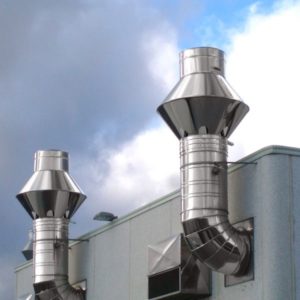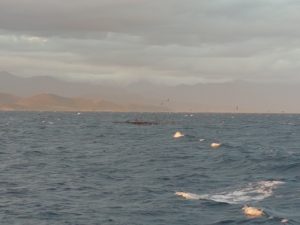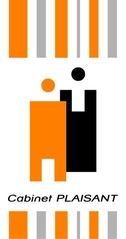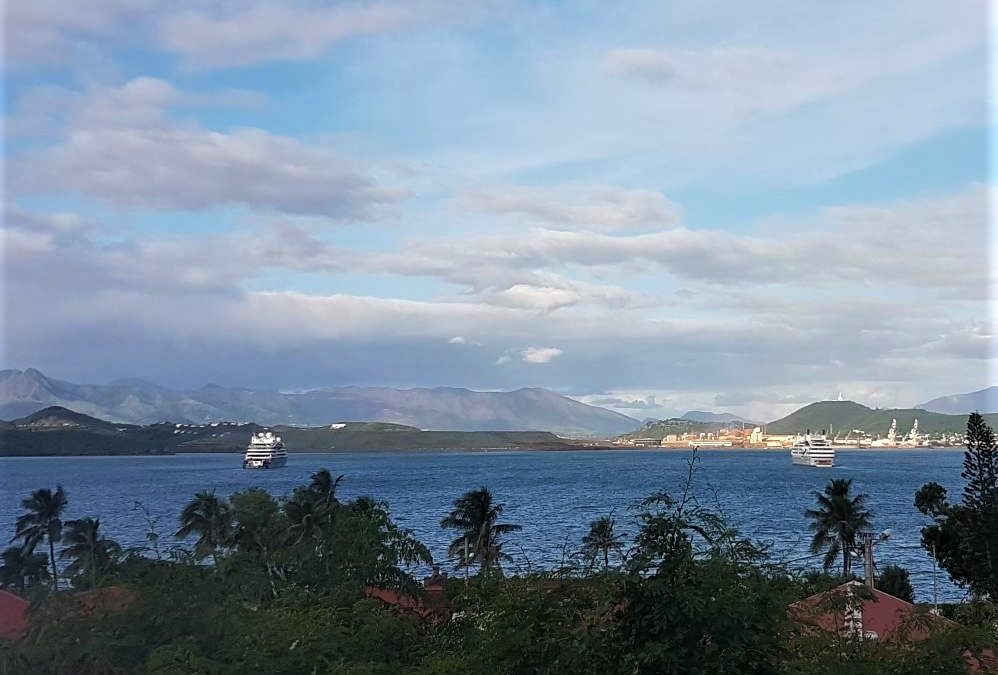In New Caledonia, the development of electricity generation has mainly been driven by the needs of the mining industry. Throughout 2013, environmental concerns focused on the choice of fuel for the new Société Le Nickel (SLN) power plant, which is located in the urban area of Nouméa.
On the occasion of the renewal of this power plant, the desire to update the regulations on large combustion plants (LCP) became a reality and, after consulting the economic operators concerned (Prony Energy, Vale NC, EEC, Enercal, SLN), the New Caledonian Industry, Mines and Energy agency (DIMENC) proposed a regulation that was adopted by the South Province Assembly on February 17, 2014.
This regulation has two main objectives. The first is to put all operators on an equal footing. Previously, LCP operators were subject to individual authorizations under the regulations on classified facilities for environmental protection (ICPE), whose requirements were set on a case-by-case basis. The discharge standards therefore differed from one plant to another. The new text aims to make them subject to the same requirements (particularly regarding pollutant emission thresholds).
The second notable objective of the deliberation is to harmonize local law with European law on environmental protection. Although the Provinces, which have jurisdiction in principle in environmental matters, are not subject to European texts, the South Province has taken as a model a European directive on large combustion plants, known as the Industrial Emissions Directive (IED), of November 24th, 2010.
Although the deliberation transcribes some of the most important provisions of the IED, its scope will be diminished by the application delays granted to existing installations as well as by the lack of an integrated pollution reduction policy in New Caledonia.
The model of the European regulatory framework on large combustion plants
To break the antagonism between industry and sustainable development, European environmental law encourages operators to periodically improve their plants. Operators must comply with emission limit values (ELVs) for each pollutant. These limits are set according to the best available techniques (BAT) specific to each industrial sector.
 Best Available Techniques – BATs are industrial techniques or processes that are evaluated on their environmental effectiveness and economic affordability. They are defined for each industrial sector in reference documents (BREFs – Best Available Techniques Reference). These documents are drawn up, updated and revised in an exchange of information between the Member States, representatives of the sectors concerned, environmental protection organizations and the European Commission. The conclusions reached define the emission levels associated with the use of these techniques.
Best Available Techniques – BATs are industrial techniques or processes that are evaluated on their environmental effectiveness and economic affordability. They are defined for each industrial sector in reference documents (BREFs – Best Available Techniques Reference). These documents are drawn up, updated and revised in an exchange of information between the Member States, representatives of the sectors concerned, environmental protection organizations and the European Commission. The conclusions reached define the emission levels associated with the use of these techniques.
Operators remain free to adopt the technical means they deem most appropriate to meet the ELVs, so that no technology (and no patent) is favoured and research into new sustainable processes is promoted.
A voluntary extension
New Caledonia is not subject to European Union environmental law. Article 20 of the amended Organic Law of 19 March 1999 recognizes the provinces as having ordinary jurisdiction, while the State and the collectivity of New Caledonia only have jurisdiction as defined in Articles 21 and 22 of this text.
Functionally, the Bureau of the Assembly of the South Province prepares the deliberations (Article 412-4 of the Environment Code of the South Province), the Assembly adopts them, and its President, as the executive, ensures the application of the texts. In other words, the latter has special police powers in relation to ICPE.
ICPEs are shared between two public bodies:
– The Industry, Mines, Energy and Quarries agency (Dimenc) examines the files and monitors the ICPEs with high risks and the metallurgical industry;
– the South Province Environmental agency (DENV) is responsible for classified installations of lesser importance.
The ICPE nomenclature presents a heading for each industrial activity (production, paper, steel, electricity, poultry, etc.). Each heading refers to a specific regulation called a Standard Deliberation.
To date, in the South Province, as well as in the North Province and the Islands, many items do not have a standard deliberation.
However, the South Province has undertaken to publish model regulations for the most critical activities and those that are the most numerous on its territory. Thus, combustion installations subject to declaration are subject to deliberation n°702-2008/BAPS of September 19, 2008 (installation whose production is greater than 2 MW, but less than or equal to 20 MW).
Prior to the February 17, 2014 deliberation, ICGs greater than 50 MW did not have special requirements. Therefore, the ICG authorization orders were subject to individualized technical requirements for each operator. Depending on the economic and political context and technological advances, the individual authorizations issued over a period of more than thirty years have presented very different ELVs. The BAPS deliberation of February 17, 2014 fills this gap in the ICPE nomenclature. ,
The PS deliberation of February 17, 2014 aims to bring the discharges of all the plants in the Southern Province up to standard. In theory, this is an extremely positive development in New Caledonian law. The legibility of the law and legal certainty would be reinforced.
Standardization of requirements
With the entry into force of the new deliberation, the nomenclature will refer to the deliberation of February 17, 2014 as regards the GICs.
The example of sulfur dioxide in coal-fired power plant emissions
Sulfur dioxide (SO2) is a gas produced by the combustion of coal (in particular), it is dangerous for health and the environment (in particular by the phenomenon of acidification of rainwater). Sulfur is present in coal in the form of pyretic sulfur, organic sulfur, sulfur salts and elemental sulfur. During combustion, the majority of sulfur oxides are produced as sulfur dioxide (SO2).
In the latest BREF (reference document in the EU), combustion plants of more than 50 MWth using coal are subject to an emission level of 200 mg/Nm3 of SO2.
The case of the Prony Energy power plant in the Deep South, which supplies part of the Vale-NC plant and part of the residential customers, is interesting since this power plant uses coal as fuel.
According to the ICPE decree n°1532 of November 21, 2005, Prony Energy has a maximum capacity of 310 MWth (maximum thermal power).
According to the authorization order of November 21, 2005 (n°15-32), the current authorized threshold is 980 mg/Nm3.
With the entry into force of the deliberation of February 17, 2014, this threshold would be lowered to 200 mg/Nm3. This represents a fivefold reduction in the current threshold.
Other major air pollutants
NOx (which includes nitrogen oxides) and carbon monoxide CO are particularly dangerous toxic gases.
- NOx:
- Prony is authorized to emit 650 mg/Nm3 of NOx,
- the deliberation reduces this value to 200 mg/Nm3
- CO:
- The plant is allowed 200 mg/Nm3 for CO
- and must comply with a limit of 150 mg/Nm3
We can note that the ELVs retained by the deliberation of February 17, 2014 are the values indicated in the BREF. In this respect, the South Province agreed to a remarkable alignment with the standards in force in the member countries of the European Union, taking into account the fact that the latter are at the forefront of the effort against atmospheric pollution on a global scale.
Consequences of non-compliance with ELVs
In metropolitan France, an operator who does not comply with the operating requirements may be subject to both administrative and criminal sanctions, as the principle of non bis in idem does not apply in the case of a combination of criminal and administrative sanctions (Cons. const., 28 July 199, dec. n° 89-260 DC, 16e consid. Journal Officiel 1 August 1989).
It should be recalled that, following the publication of LOI n° 2013-1029 of November 15, 2013 on various provisions relating to overseas territories (JONC n° 8974 of December 10, 2013), the criminal sanctions provided for in the Environmental Code of the South Province were made applicable. The criminal penalties applicable to violations of the ICPE regulations are set out in Articles 416-14 to 416-22 of the South Province Environmental Code.
In addition, it should be noted that a violation of the health of residents living near combustion installations could fall within the jurisdiction of the judicial courts, which would use the provisions of ordinary law to impose financial penalties on the operators (see the application by the Court of Cassation of the theory of abnormal neighbourhood disturbances to classified installations and, by way of illustration, for fluorine emanations: Cass. 3e civ., 19 November 1980).
Time limits for application and review: an open-ended extension of the constraints of the new decree for existing plants
In mainland France, the decree transposing the IED Directive set the deadline for the application of new standards for existing facilities at three years (Decree no. 2013-374 of 2 May 2013).
 In the South Province, while new installations will be immediately subject to the requirements of the BAPS deliberation of February 17, 2014, existing installations will be able to benefit from exemptions for indefinite periods (Article 3).
In the South Province, while new installations will be immediately subject to the requirements of the BAPS deliberation of February 17, 2014, existing installations will be able to benefit from exemptions for indefinite periods (Article 3).
Indeed, although existing facilities are given a 6-year deadline to comply with the new requirements, the operator who “considers that the provisions (…) are not technically and economically feasible” will be able to file, within one year, an audit.
This audit must include :
– An analysis of the operation of the facility, specifying the investments made since the facility was commissioned to reduce pollution;
– An evaluation of the means of pollution reduction that the operator proposes on the basis of the BATs, and the provisions of the deliberation;
– A summary of the audit on the different scenarios chosen.
Important note: the audit will be submitted for public consultation. This procedure will facilitate the information of the civil society. The product of the consultation may be taken into account by the administrative judge in the context of the control of the validity of the cost-benefit balance carried out by the President of the South Province.
The deliberation specifies that, following this audit: “in the event that it is technically and economically impossible to comply fully with the requirements of the deliberation (…), the President of the SP may set, by way of decree, any compensation measures deemed relevant and proportionate”.
As a reminder, the usual compensation measures are CO2 storage/capture, revegetation, funding of scientific research or participation in the creation or maintenance of protected areas.
As pointed out by the Economic and Social Council in its Opinion No. 32/2013 published on October 31, 2013, the margin of maneuver of the Provincial President is very important.
This discretionary power represents a lack of visibility for operators and a significant source of litigation.
The challenge to the compensation measures may concern, for example, compliance with the principle of equivalence (1) or the definition of the surface compensation ratio. By way of illustration, it should be noted that censures have been issued for inadequacy of the impact study when there is too much uncertainty about the technical methods of reconstitution (TA Lyon, 1 October 2005, n° 0506497, Cne Sainte-Catherine et a).
In addition, the inequality of thresholds between existing and new installations could constitute, if it were to persist, an infringement of the principle of equality before the law.
In short, the extent of the power granted to the President of the South Province aggravates the situation of legal uncertainty in New Caledonia. Given the economic stakes involved in this industry, the lack of predictability of the norm is a damaging factor both for the operators and for the inhabitants.
The periodic review: the keystone of the IED Directive
The IED Directive implements a legal mechanism that allows for the automatic improvement of technologies used in industry. As soon as new technologies are developed, they can be validated as BAT by a commission of scientists and professionals. The emission thresholds that are achievable with these new technologies then become the new ELVs. These values are published in an official document containing the conclusions on BAT.
The new directive provides for the triggering of the review to be linked to the publication of the BAT conclusions for the main section of the establishment. Within one year of this publication, a review dossier must be submitted by the operator and within 4 years, the permit conditions must be adapted to the new BAT conclusions.
In this way, operators are obliged to adapt their operations periodically to technological progress. At the same time, research and development of new clean technologies (new processes, filters, capture methods, etc.) are encouraged. The IED Directive detaches the setting of new ELVs from the conventional political process (European Institutions) by establishing a quasi-automatic recognition of new clean technologies. By ensuring that the thresholds achievable with these technologies will become the binding standard, the IED Directive offers a competitive advantage to industries that invest in the search for better environmental processes.
Contrary to its European model, the deliberation of the Southern Province on large combustion plants will not put in place a systematic review linked to the validation of new BATs.
This is unfortunate, since New Caledonia has a large and specialized industrial park, as well as high-level engineers and scientists, and could contribute to the development of new, more sustainable techniques. With the BAT validation system, this effort could bear fruit on the European market. However, as the New Caledonian nickel industry is in a competitive market where most of its competitors (Indonesia, China) are subject to lax environmental standards, the regular adaptation of the electrical production units would entail an unfavourable financial cost.
In the absence of a revision linked to BAT, the Southern Province’s ICPs will be subject to the provisions of Articles 413-33 and 413-37 of the Environmental Code (PS). According to these texts, every 10 years, following the communication and analysis of the operating report that must be sent to the ICPE services (DIMENC), the President of the Province is able to prescribe new obligations.
Finally, although the Kyoto Protocol on the fight against greenhouse gases is not applicable in New Caledonia, the deliberation subject of the present article provides that during the ten-year assessment, CO2 emissions (only) are monitored and measures to reduce them are defined (greenhouse gas assessment + energy performance assessment).
As a reminder, CO2 is the main greenhouse gas emitted by power plants burning organic fossil fuels (fuel oil, coal).
In the end, the two provisions dealing with the ten-year review have the same shortcoming as the audit system: they do not provide a framework for the decision-making power of the competent authority (the President of the South Province).
Here again, the predictability of standards is very limited. This may be highly questionable from a legal point of view, given the constitutional principle of the intelligibility of standards. As the New Caledonia Land Use and Development Plan emphasizes (Workshop 9, Administration, point 3.6): “(…) despite the incomplete nature of the regulations, a significant proportion of the texts in force are either difficult to apply because they are too old, or are legally fragile because of the complexity of the attribution of competences and/or the procedures to be respected, or because they do not conform to international law. The context observed at the global level, of a reinforcement of citizens’ recourse to the courts, could, if it were to become widespread in New Caledonia, lead to an inextricable situation: the Caledonian is not a litigant and if he were to become one, the consequences could be worrying.
The lack of planning and an integrated approach in New Caledonia
One of the contemporary developments in the law on classified installations lies in its capacity to take into account the legislative objectives of other special policies.
In mainland France, classified installations must comply with the requirements of the planning documents of sectoral laws (town planning, water, waste, quarries and air). This is a genuine regulatory planning process, as these provisions are enforceable against the ICPE authorization; in other words, planning constitutes a particular method of developing the standard, with regard to the legal system.
Thus, stricter limit values can be set by prefectural decree if this is necessary to comply with the objectives set by the air protection plans. The IPPC Directive (Dir. 2008/1, cited above n° 139, art 10. – Dir. 2010/75, cited above n° 33, art. 18) provides that more stringent conditions than those achievable through the use of BAT are required when necessary to ensure compliance with an environmental quality standard.
With the South Province’s deliberation on ICMs, the President of the Province remains able to make more stringent prescriptions, taking into account health and environmental protection.
Article 4 of the Deliberation under comment recalls that the constraints imposed represent the minimum requirements to be respected and that greater constraints may be given to operators to protect “dangers or inconveniences either for the convenience of the neighborhood, or for health, safety, public health, or for agriculture, or for the protection of nature and the environment, or for the conservation of sites and monuments” (article 412-1 of the CEPS).
However, these measures are within the discretionary power of the authorities. If New Caledonia had an air quality plan, the authorization orders would have to take into account the thresholds set by such a document in order to reduce the ELVs of the operation, if necessary.
Only protected areas should be considered in the development of ICM orders.
The absence of a binding air quality plan at the level of New Caledonia, the Province or only Greater Nouméa makes it uncertain and hypothetical to prescribe such measures in a preventive manner, i.e. when preparing or revising the authorization order.
A regulation on air quality could be in preparation by the DIMENC. It would then be necessary to examine the way in which this regulation would be integrated or superimposed on the current system of authorization for classified installations.
Large combustion plants BREFs update
The first version of the BREF for large combustion plants (LCP) was published in 2006. The process of revising this BREF started in 2011 and the work lead to the publication of the Implementing Decision on BAT Conclusions for Large Combustion Plants of 31 July 2017.
The drafting of the document involved 140 experts representing operators, NGOs and Member States, who used data from 580 installations collected to define BAT and BAT-AELs.
It is from the conclusion chapter of this BREF on large combustion plants that the European Commission drafted the Decision 2017/1442 of July 31, 2017 establishing the conclusions on best available techniques (BAT) for large combustion plants, published on August 17, 2017.
These conclusions are structured as follows:
- general conclusions applicable to all facilities, including BAT for emissions monitoring, combustion efficiency, energy efficiency, waste management, and BAT-AELs for water releases,
- fuel-specific conclusions that apply in addition to the general conclusions and relate to the combustion of solid fuels (coal, lignite, solid biomass, peat), liquid fuels (heavy fuel oil, diesel), gaseous fuels (natural gas, steelmaking gases), the combustion of fuels from chemical industry processes as well as co-incineration and gasification. These conclusions mainly deal with energy efficiency and air emissions for which BAT-AELs have been defined.
In 2022, facing an unprecedented demand for nickel, New Caledonian authorities must take into account the new BREFs to shape the energy production strategy of the territory.
We can only hope that the demand for “green nickel” will keep the government away from new fossil fuels plants.
Otherwise, the energy revolution tag that is sold with electric cars will only be another government backed greenwashing scheme.
Matthieu Machevin
Note
(1) The doctrine published on March 6, 2012 by the Ministry of Ecology on the ERC sequence specifies the principle of equivalence: compensation measures “must allow the environmental quality of the impacted natural environment to be restored to a level at least equivalent to the initial state and, if possible, to obtain a net gain, particularly for degraded environments, taking into account their sensitivity and the general objectives of achieving good environmental status… They are defined at the relevant territorial scale and taking into account the recovery time of natural environments.


Recents comments